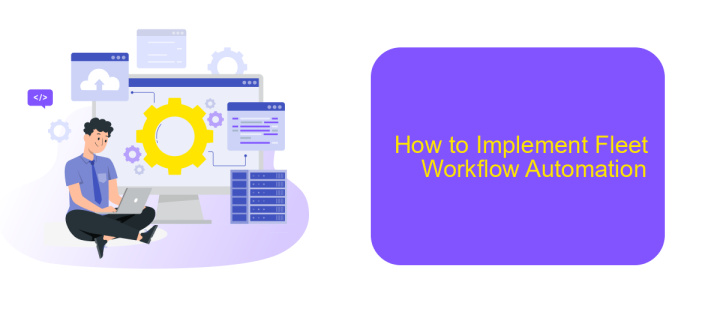Fleet Workflow Automation
In today's fast-paced logistics industry, fleet workflow automation is revolutionizing how businesses manage their transportation operations. By integrating advanced technologies such as AI, IoT, and real-time data analytics, companies can optimize routes, enhance vehicle maintenance, and improve overall efficiency. This article explores the key benefits and practical applications of fleet workflow automation, guiding you through the future of seamless fleet management.
Fleet Workflow Automation: A Guide to Improved Efficiency
Fleet workflow automation is essential for modern businesses seeking to enhance operational efficiency. By automating routine tasks, companies can significantly reduce manual errors, save time, and improve overall productivity. Implementing an effective automation strategy can streamline processes such as vehicle maintenance, route planning, and driver management.
- Automate scheduling and dispatching to optimize route planning.
- Monitor vehicle health and schedule maintenance automatically.
- Integrate telematics for real-time tracking and data analysis.
- Use tools like ApiX-Drive to connect and automate various fleet management systems.
By leveraging tools and services like ApiX-Drive, businesses can seamlessly integrate multiple systems, ensuring data flows smoothly between them. This integration not only reduces the need for manual data entry but also provides real-time insights, helping managers make informed decisions quickly. Ultimately, fleet workflow automation leads to improved efficiency, cost savings, and a more streamlined operation.
What is Fleet Workflow Automation?

Fleet Workflow Automation refers to the use of technology to streamline and optimize the various processes involved in managing a fleet of vehicles. By automating routine tasks such as maintenance scheduling, fuel management, and route planning, fleet managers can significantly reduce operational costs and improve overall efficiency. This automation not only helps in minimizing human errors but also ensures that the fleet operates at peak performance with minimal downtime.
One of the key components of Fleet Workflow Automation is the integration of different software systems to create a cohesive workflow. Services like ApiX-Drive facilitate these integrations by allowing various applications to communicate seamlessly with each other. For instance, data from GPS tracking systems can be automatically synced with maintenance software to schedule timely servicing. This level of integration ensures that all aspects of fleet management are interconnected, providing real-time insights and enabling proactive decision-making.
Benefits of Fleet Workflow Automation

Fleet workflow automation significantly enhances operational efficiency by streamlining various tasks and processes. It eliminates the need for manual intervention, reducing human error and accelerating task completion. This results in more accurate data handling and improved decision-making capabilities.
- Increased Productivity: Automation allows fleet managers to focus on strategic tasks rather than repetitive ones.
- Cost Savings: By reducing the need for manual labor, businesses can save on operational costs.
- Enhanced Compliance: Automated systems ensure that all regulatory requirements are consistently met.
- Better Data Management: Automation tools provide real-time data analytics, improving fleet performance monitoring.
- Seamless Integration: Services like ApiX-Drive facilitate easy integration of various systems, ensuring a cohesive workflow.
Implementing fleet workflow automation is a strategic move that offers numerous benefits, from cost savings to enhanced productivity. By leveraging tools like ApiX-Drive, businesses can seamlessly integrate different systems, ensuring a smooth and efficient operation. This not only boosts overall performance but also provides a competitive edge in the industry.
How to Implement Fleet Workflow Automation

Implementing fleet workflow automation begins with a thorough assessment of your current processes. Identify repetitive tasks that consume significant time and resources. Understanding these pain points will help you determine which areas will benefit most from automation.
Next, select the right tools and software that align with your fleet management needs. Look for solutions that offer seamless integration with your existing systems. ApiX-Drive, for instance, can facilitate the integration process by connecting various applications and automating data transfer between them.
- Assess current workflows and identify automation opportunities
- Choose appropriate automation tools and software
- Integrate selected tools with existing systems using services like ApiX-Drive
- Train your team on new automated processes
- Monitor and optimize the automated workflows regularly
Finally, it's crucial to provide adequate training for your team to ensure smooth adoption of the new automated processes. Regular monitoring and optimization will help you address any issues promptly and keep the system running efficiently. This approach will lead to increased productivity and reduced operational costs.
Best Practices for Fleet Workflow Automation
Implementing fleet workflow automation requires a strategic approach to ensure efficiency and effectiveness. Start by conducting a thorough analysis of your current processes to identify bottlenecks and areas for improvement. Standardize procedures and create clear documentation to ensure consistency across the fleet. Leveraging technology, such as telematics and GPS tracking, can provide real-time data and insights, enabling proactive decision-making and better resource management.
Integration of various systems is crucial for seamless workflow automation. Utilizing tools like ApiX-Drive can facilitate the integration of disparate systems, ensuring data flows smoothly between different platforms. Regularly review and update your automation processes to adapt to changing needs and technologies. Training your team on new systems and procedures is essential for successful implementation. Finally, continuously monitor performance metrics to identify areas for further optimization, ensuring your fleet operates at peak efficiency.
- Automate the work of an online store or landing
- Empower through integration
- Don't spend money on programmers and integrators
- Save time by automating routine tasks
FAQ
What is Fleet Workflow Automation?
How can Fleet Workflow Automation benefit my business?
What types of tasks can be automated in fleet management?
How do I integrate Fleet Workflow Automation into my existing systems?
Is Fleet Workflow Automation scalable for growing businesses?
Apix-Drive will help optimize business processes, save you from a lot of routine tasks and unnecessary costs for automation, attracting additional specialists. Try setting up a free test connection with ApiX-Drive and see for yourself. Now you have to think about where to invest the freed time and money!


